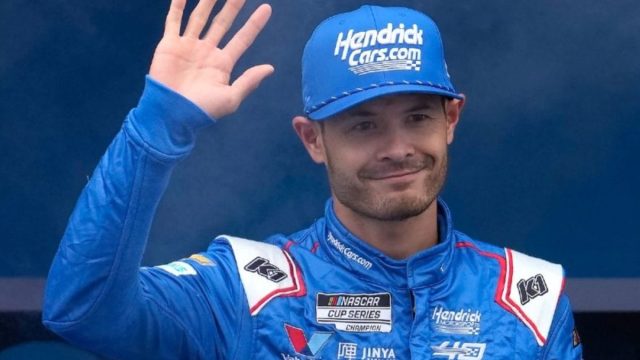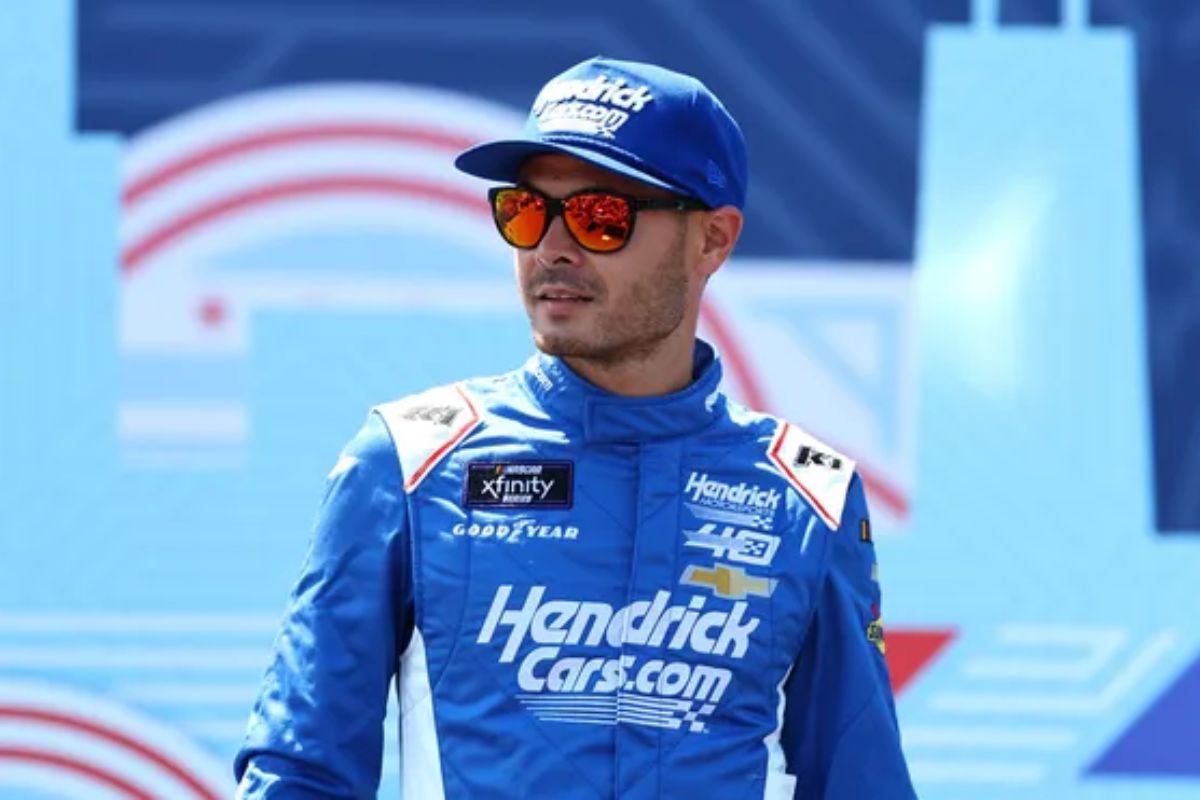Kyle Larson’s Selfish Wish For Brad Keselowski: Kyle Larson‘s recent remark regarding his hope that Brad Keselowski‘s Mustang would run out of fuel during the race at Indianapolis Motor Speedway opens a compelling dialogue about the ruthless competitiveness inherent in NASCAR. This frank expression highlights Larson’s aggressive mindset and reveals the underlying complexities of fuel strategy, which can dramatically alter race outcomes. As the subtleties of such rivalries unfold on the track, one must consider how these sentiments influence driver dynamics and performance—especially as the stakes rise in the remaining races of the season.
Key Highlights
- Larson’s hope for Keselowski’s fuel strategy to fail reflects the competitive mindset prevalent in NASCAR racing.
- Fuel strategy intricacies are crucial, as they can significantly impact race outcomes and individual driver performance.
- Larson’s aggressive racing style demonstrates the mental tactics employed in NASCAR to achieve victory.
- His victory at Indianapolis was aided by Keselowski’s fuel issues, showing Larson’s skill in capitalizing on competitors’ mistakes.
Larson’s Candid Comment on Keselowski’s Fuel Strategy
Reflecting on the dynamics of race strategy, Kyle Larson straightforwardly expressed his hopes that Brad Keselowski’s fuel strategy would falter at a critical moment during the Indianapolis race, emphasizing the competitive nature of NASCAR where drivers often prioritize their own positions over fellowship.
Larson’s frank admission reveals a multifaceted perspective on driver psychology; it illustrates how individual aspirations can supersede camaraderie in the heat of competition.
“It was just obviously selfish and I’m praying for him to run out of fuel once we were two-wide for the restart.”
“I didn’t care where he ran out of fuel, I just wanted him to run out of fuel so that I could take over the front row.” – Larson
The intricacies of fuel strategy can serve as a definitive competitive edge in NASCAR, dictating race tactics that can make or break a driver’s performance.
Larson’s desire for Keselowski’s fuel to run dry highlights his aggressive approach and reflects the team dynamics that underpin each driver’s strategy.
Larson’s Triumph After Keselowski’s Exit
With Brad Keselowski’s unexpected exit from the race due to fuel issues, Kyle Larson seized the opportunity to assert his dominance, ultimately securing a victory amidst fierce competition from Tyler Reddick and Ryan Blaney. Larson’s ability to capitalize on Keselowski’s miscalculation was a reflection of his keen understanding of race dynamics and fuel management.
Larson’s mindset during this significant moment was essential; he effectively navigated the track, veering to the inside of Blaney to take the lead. This tactic not only displayed his competitive edge but also highlighted the importance of strategic positioning in racing.
As Larson reflected on the race, he acknowledged the intricate balance of luck and skill involved. “With the way the strategy was working out, Brad running out of fuel, me inheriting the front row and all that,” he remarked.
“Just a lot had to fall into place, and thankfully, it did. So I just can’t believe it.” – Larson
Larson’s Season and Upcoming Races
Kyle Larson’s remarkable season has positioned him as both the points leader and the standout driver, showcasing his exceptional skill and consistency as he heads into the final stretch of races before the 2024 playoffs. With only four races remaining, including the significant event at Richmond Raceway on August 11.
As Larson continues to dominate, rival driver dynamics play a critical role in shaping the championship landscape. His ability to navigate these relationships while maintaining a competitive edge is essential for securing his position. Furthermore, team performance analysis indicates that Larson’s crew has excelled in race day preparations, optimizing vehicle setup and strategy to improve his chances of success.
Moreover, Larson’s fan engagement strategies have proven effective, bolstering his support base and elevating his profile in the sport. By connecting with fans through social media and community events, he has cultivated a loyal following that can provide a psychological advantage on race day.
Larson’s Redemption After Failed Double Duty Attempt
A victorious return to the Indianapolis Motor Speedway marked a significant redemption for Larson after his disappointing attempt at Double Duty earlier in the season. The challenges faced during that May endeavor, including a rain delay that crushed his plans, highlighted the unpredictable nature of motorsport and the critical importance of race strategy.
Larson’s subsequent victory at IMS exhibited not only his driver resilience but also the effective dynamics of his team. Crew chief Cliff Daniels emphasized the emotional weight of racing a paint scheme representing what Larson had missed earlier, amplifying the significance of this win. This success not only restored Larson’s confidence but also reinforced the importance of adaptability in steering through race day challenges.
“I mean, the paint scheme was almost the car that Kyle Larson never raced, So to be able to have that paint scheme and to race it, and then to bring home a win at the Brickyard makes it that much more special.” – Daniels
The successful execution of race strategy, combined with the support of his team, allowed Larson to reclaim his narrative at the Brickyard, transforming past disappointments into a foundation for future achievements.
As Larson moves forward, this Indy redemption serves as a potent reminder of the resilience required in elite motorsport, laying the groundwork for a promising trajectory in his racing career.
Larson’s Future Plans and Team’s Break
Following his recent victory at Indianapolis, Larson is already envisioning future endeavors, including a hopeful return to the Memorial Day double-header. Meanwhile, his team prepares for a well-deserved break during the upcoming two-week hiatus coinciding with the Summer Olympics in Paris. This interval presents a critical opportunity for Larson’s team dynamics to strengthen, as the crew can reflect on their successes and strategize for upcoming races.
During this summer break, team members will engage in activities that foster collaboration, potentially leading to groundbreaking future race strategies. The time off allows for a thorough analysis of performance metrics, enabling Larson and his team to refine their approach as they look toward the next season. Furthermore, the possibility of driver collaborations could emerge, enhancing competitive edge through shared insights.
News in Brief: Kyle Larson’s Selfish Wish For Brad Keselowski
Kyle Larson’s candid hope that Brad Keselowski’s fuel strategy would fail at Indianapolis underscores NASCAR’s fierce competitiveness. Larson’s victory, following Keselowski’s exit due to fuel issues, showcased his strategic acumen and aggressive racing style. As the season leader, Larson’s consistency and skill have set him apart as he heads into the playoffs. His redemption at Indianapolis, after a failed Double Duty attempt, highlights his resilience. With a two-week break during the Summer Olympics, Larson’s team will strategize for upcoming races, aiming to maintain their competitive edge and secure future successes.
ALSO READ: Kyle Larson and Ryan Blaney’s Dispute Post Brickyard 400 at Indianapolis Motor Speedway



